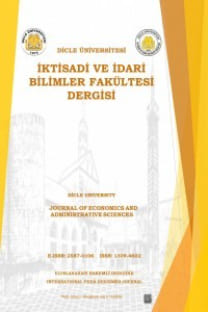GELİR GRUPLARINA GÖRE COVID-19 PANDEMİSİNDE SAĞLIK SİSTEM PERFORMANSI ETKİNLİĞİNİN ÖLÇÜLMESİ
COVID 19, Veri Zarflama Analizi, Sağlık Sistem Performansı, Gelir Grupları
MEASURING HEALTH SYSTEM PERFORMANCE EFFICIENCY IN THE COVID-19 PANDEMIC BY INCOME GROUPS
___
- Adang, E. M., & Borm, G. F. (2007). Is There an association between economic performance and public satisfaction in health care? The European Journal of Health Economics, 8(3), 279-285.
- Cansever, İ. H., & Şenol, O. (2022). Gelişmiş ülkelerin sağlık sistemleri verimlilikleri ile COVID-19 performansları ilişkisi üzerine bir araştırma. Anadolu Üniversitesi Sosyal Bilimler Dergisi, 22(2), 611-628.
- Charnes, A., Cooper, W. W., & Rhodes, E. (1978). Measuring the efficiency of decision making units. European Journal of Operational Research, 2(6), 429-444.
- Choi, E. M. (2021). COVID-19 vaccines for low-and middle-income countries. Transactions of the Royal Society of Tropical Medicine and Hygiene, 115(5), 447-456.
- Cooper, W. W., Seiford, L. M., & Tone, K. (2007). Data envelopment analysis: a comprehensive text with models, applications, references and DEA-solver software (Vol. 2, p. 489). New York: Springer.
- De Cos, P. H., & Moral-Benito, E. (2014). Determinants of health-system efficiency: evidence from OECD countries. Int J Health Care Finance Econ, 14, 69–93.
- Duran, D., Bauhoff, S., Berman, P., Gaudet, T., Konan, C., Ozaltin, E., & Kruk, M. E. (2020). The role of health system context in the design and implementation of performance-based financing: evidence from Cote d’Ivoire. BMJ Global Health, 5(9), e002934.
- Flaxman, S., Mishra, S., Gandy, A., Unwin, H. J. T., Mellan, T. A., Coupland, H., ... & Bhatt, S. (2020). Estimating the effects of non-pharmaceutical interventions on COVID-19 in Europe. Nature, 584(7820), 257-261.
- Gannon, B. (2004). Technical efficiency of hospitals in Ireland (No. HRBWP18).
- Hadad, S., Hadad, Y., & Simon-Tuval, T. (2013). Determinants of healthcare system’s efficiency in OECD countries. The European Journal of Health Economics, 14(2), 253-265.
- Hollingsworth, B. (2008). The measurement of efficiency and productivity of health care delivery. Health Economics, 17(10), 1107-1128.
- Ibrahim, M. D., Daneshvar, S., Hocaoğlu, M. B., & Oluseye, O. W. G. (2019). An estimation of the efficiency and productivity of healthcare systems in Sub Saharan Africa: health centred millennium development goal based evidence. Social Indicators Research, 143(1), 371-389.
- IOM. (2022). National Migration Health Physicianb https://www.iom.int/sites/g/files/tmzbdl486/files/inline-files/national-migration-health-physician-nob-zambia-2022-correct.pdf Erişim tarihi: 02.06.2023
- Mete, B., Şimşir, İ., & Kırılmaz, H. (2022). COVID-19 pandemisinde sağlık sistemlerinin performansı üzerine geleneksel bir derleme. Turkiye Klinikleri J Health Sci, 7(3), 919-30.
- Mirmirani, S., Li H. C., & Ilacqua, J. A. (2008). Health care efficiency in transition economies: an application of data envelopment analysis. International Business & Economics Research Journal, 7(2), 47-56.
- Patanavanich, R., & Glantz, S. A. (2020). Smoking is associated with COVID-19 progression: a meta-analysis. Nicotine and tobacco research, 22(9), 1653-1656.
- Ranney, M. L., Griffeth, V., & Jha, A. K. (2020). Critical supply shortages—the need for ventilators and personal protective equipment during the COVID-19 pandemic. New England Journal of Medicine, 382(18), e41.
- Retzlaff-Roberts, D., Chang, C. F., & Rubin, R. M. (2004). Technical efficiency in the use of health care resources: A comparison of OECD countries. Health Policy, 69, 55–72.
- Sel, A. (2021). COVID 19 pandemisinde sağlık sistemi gelişmelerinin etkinliğinin ölçülmesi: G-20 üzerine bir inceleme. Kırklareli Üniversitesi İktisadi ve İdari Bilimler Fakültesi Dergisi, 10(2), 181-202.
- Selamzade, F., & Özdemir, Y. (2020). COVID-19’a karşı OECD ülkelerinin etkinliğinin VZA ile değerlendirilmesi. Electronic Turkish Studies, 15(4), 977-991.
- Shirouyehzad, H., Jouzdani, J., & Khodadadi Karimvand, M. (2020). Fight against COVID-19: a global efficiency evaluation based on contagion control and medical treatment. Journal of Applied Research on Industrial Engineering, 7(2), 109-120.
- Tone, K., & Tsutsui, M. (2010). Dynamic DEA: A slacks-based measure approach. Omega, 38(3-4), 145-156.
- Woldometers. (2023). COVID-19 Coronavirus Pandemic. https://www.worldometers.info/coronavirus/ Erişim tarihi: 02.06.2023
- WHO. (2018). Tobacco. https://www.who.int/health-topics/tobacco Erişim tarihi: 01.06.2023
- World Bank. (2023a). DataBank. https://data.worldbank.org/ Erişim tarihi:30.05.2023
- World Bank. (2023b). New World Bank country classifications by income level: 2022-2023. https://blogs.worldbank.org/opendata/new-world-bank-country-classifications-income-level-2022-2023 Erişim tarihi: 01.06.2023
- Yesilaydin, G. (2019). Examination of differences in health indicators between efficient and inefficient countries. Pak J Med Sci., 35(1), 172-176.
- ISSN: 1309-4602
- Yayın Aralığı: Yılda 2 Sayı
- Başlangıç: 2011
- Yayıncı: Dicle Üniversitesi
Meral EROL FİDAN, Nur Kuban TORUN, Serpil TÜRKYILMAZ
BAŞLICA ENERJİ KAYNAKLARI VE ÇEVRESEL ETKİLERİNİN DEĞERLENDİRİLMESİ
TÜRKİYE’DE KATILIM BANKALARI VE KONVANSİYONEL BANKALAR ARASINDAKİ REKABET ÜZERİNE NİCEL ARAŞTRMA
Ali Rıza SOLMAZ, Özgür Bayram SOYLU
ÜLKELERİN GELİŞMİŞLİK FARKLILIKLARI ÖZGÜRLÜK YAPISI İLE AÇIKLANABİLİR Mİ?
SİMÜLASYON TEMELLİ TIP EĞİTİMİN BÜTÇEYE SAĞLADIĞI KLİNİK VE EKONOMİK FAYDALAR
BIST SİGORTA ŞİRKETLERİNİN CRITIC TEMELLİ PROMETHEE II YÖNTEMİ İLE PERFORMANS ANALİZİ
EKONOMİK KRİZ VE HALK EKMEK KUYRUKLARI: MERSİN ÖRNEĞİ
Erkan AKTAŞ, İhsan KAMALAK, İlkay YILMAZ
TÜRKİYE’DEKİ HAYAT DIŞI SİGORTA ŞİRKETLERİNİN ETKİNLİK ÖLÇÜMÜ
TÜRKİYE’DE STANDART OLUŞTURULMASI SÜRECİNE İLİŞKİN BİR DEĞERLENDİRME: KÜMİ FRS ÖRNEĞİ
Nurettin ÖZDEMİR, Elçin DALKILIÇ
COVID-19 PANDEMİSİ SÜRECİNDE KIRILGAN GRUP OLARAK SIĞINMACILARA YÖNELİK UYGULANAN POLİTİKALAR
